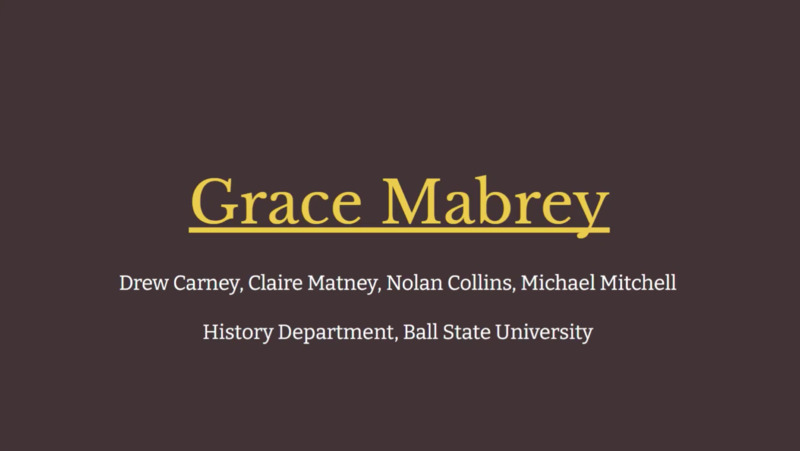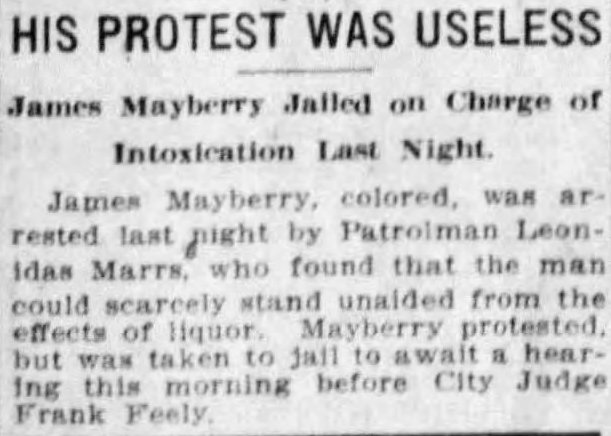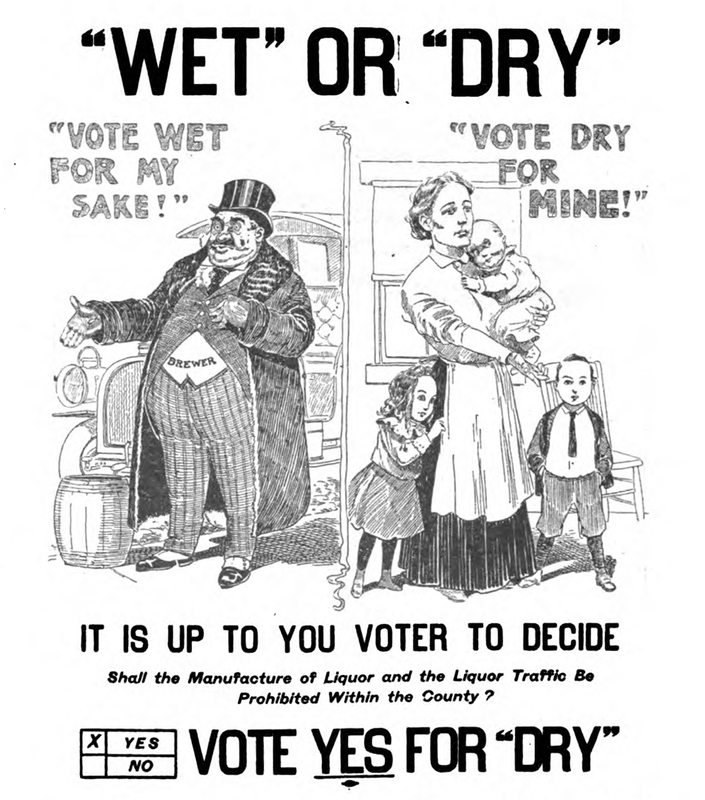Grace Shoecraft Mabrey
Grace Shoecraft Mabrey first appeared in Muncie's newspapers in March 1902 when she applied for a divorce from her husband James Mabrey. She stated that he was a gambler and had deserted her in a Lima, Ohio boarding house. When he lost their money and could not pay the rent, the landlord confiscated everything but her clothes. Although the judge did not grant Grace a divorce from James, she would appear more frequently in Muncie's newspapers for both her husband's and her own misconduct until her death in 1919.
This biography video was researched and created by Drew Carney, Nolan Collins, Claire Matney, and Michael Mitchell.
In 1847, decades before Grace Shoecraft was born, the British artist George Cruikshank published a series of engravings entitled The Bottle. The engravings were extremely popular in the decades of rising prohibitionist feeling. They followed a white couple and their three children from the moment when alcohol first arrived in their home to the household's destruction. As the etching below shows, when the husband first encourages his wife to drink and the result is good-natured merriment.
As the etchings progress the couple becomes more dependant on alcohol and their wealth, health, and social position deteriorate. As the etching below shows, the husband is fired form his job for drunkeness, and he becomes despressed. This drives his wife to sell their belongings to pay the bills and buy more to drink. Soon their furniture is repossessed and alcohol is the couple's only consolation. To feed themselves the children and wife resort to begging in the street.
Lack of money and lack of care leads to the death of the youngest child. The ragged family lives in a shack in contrast to their former middle-class home. Soon the strain leads to arguments and the husband beats his wife, eventually killing her. The husband's crime send him to an insane asylum and the children make their way on the streets as best they can. Cruikshank's depiction of family breakdown sold thousands of copies and was closely recreated by other artists through the nineteenth century. This popularity signals how much nineteenth and early twentieth-century viewers identified alcohol with a path leading towards household destruction.
In the early 1900s, newspaper readers in Muncie might have mistaken Grace Shoecraft and James Mabrey for the couple in these etchings. However, the fact that they were members of the black working class constructed a very different narrative for readers. In 1903 James was described as the "proprietor of the colored club house" when he was brought before Muncie's court for selling liquor on a Sunday. In 1905 he worked at Hemingray's Glass Company, but by then Muncie readers knew James for fines levied after convictions for assault and fighting. These convictions would continue through the decade and be augmented by arrests for gambling, illegal liquor sales, and violent interactions.
Left: "Says Husband Spanked Her," The Star Press, May 16, 1905.
As Denise Herd has argued, in the late nineteenth and early twentieth centuries advocates of prohibiting alcohol found the connection between public intoxication and violent behavior to be a potent argument. In addition, the money spent on alcohol was considered lost to the household and its children. In particular, some white prohibitionists used the stereotype of the violent black drinker to urge curtailing alcohol as a public safety measure. Reports of James Mabrey's arrests, like those shown here (left and below), fed these stereotypes, but no article questioned whether Grace might have used the money that James spent on alcohol or paid in fines to care for their two children.
In Cruikshank's etchings, the wife follows her husband into alcoholism and misery, and she meets a violent end. While Grace might have shared aspects of James' behavior, it is impossible to know the couple's day to day experiences. No records of their lives survive beyond census reports, city directory entries, death certificates, and an abundance of newspaper articles. Although Muncie's newspapers identify moments of crisis in the couple's lives, they ignored the couple's daily life.
Left: "Protest was Useless," The Star Press, June 3, 1910.
As the methodology video notes, research uncovered a complication that makes conclusions about Grace's life difficult and uncertain. Grace's brother, Arthur Shoecraft, was married to a white woman also named Grace. The 1910 federal census (below) states that they married in 1905, when she was 17 and he was 24. The census reports that Arthur was a laborer at the bolt works, and that neither one could write. They lived on South Jefferson Street and Grace's (white) father, James Hale, a barber shop porter, lodged with them. Between 1905 and 1910, Muncie's newspapers announced that this Grace Shoecraft had been arrested six times for immorality (thrice), public intoxication (twice), and associating (once). Often she was described as white, and never was she called Mabrey or Mayberry.
In this period of relatively low literacy, newspapers and census recorders had difficulty spelling the names of African Americans and immigrants. They often resorted to phonetic spellings of unfamiliar names. Even considering this, there was a separation between Grace (born Hale, Arthur's wife), who was arrested about once a year, and Grace (James' wife), who sought protection from a violent husband.
Left: "Two Notorious Women Reprimanded," The Star Press, August 11, 1909.
Indeed, in 1905 James was arrested for assaulting Grace, their infant Ruth, and her parents in a separate incident. The judge dismissed the charge against James and warned Grace not to make frivolous accusations. In June 1905 a jury of black men found James guilty of assaulting his mother-in-law and fined him one cent plus costs ($25). In its account of the trial, The Star Press noted that this was likely the first all-black jury in Delaware County and that many readers might have thought "that a colored jury would never convict a person of their own color." The complicated nature of Grace's life, as a black woman with a violent husband and a notorious white sister-in-law continued through the next decade.
Above: The Muncie_Evening_Press, March 1, 1915.
Through the 1910s Muncie’s newspapers reported Grace Mabrey to be in various difficulties. In 1910 Clayton Blakely, feverish with typhoid, apparently threatened her household with concealed weapons. In August 1913, both Grace and James were arrested for public intoxication. The judge fined and jailed Grace for twenty days for failing to appear in court previously to testify in James’ earlier assault trial. In September 1915, James was arrested for selling illegal alcohol out of a shed behind their house. In 1916, their twelve-year-old daughter Ruth, who was living with her grandmother, died of a brain hemorrhage. Only three years later Grace died of broncho-pneumonia.
Left: "James Mayberry in Bad Again," Muncie Evening Press, November 21, 1914.
Life was hardly easy for Grace’s white sister-in-law. In December 1914, Grace Hale Shoecraft was arrested for prostitution and Arthur was arrested for stealing 300 pounds of coal. (It seems that Grace and James Mabrey were also arrested for this theft.) In March 1915 both were fined for public intoxication. In June and August 1919 Grace was fined again for public intoxication. Although the fines were often $1 plus costs, on several occasions lack of cash meant that she paid the fine with jail time. In February 1922 Grace Hale Shoecraft died of chronic alcoholism. Seeing her life through these fines and arrests, undermines the belief that race made one more or less susceptible to addiction or crime.
Left: "'Wet' or 'Dry,' Shall the Mothers and Children be Sacrificed to the Financial Greed of the Liquor Traffic? It is up to you, voter, to decide. Vote dry" (USA, early 1900s)
As Cruikshank's etchings and the prohibitionist campaign poster (left) remind us, women were often victims of alcohol and violence. Often American and British artists depicted white women in those victimized roles. Rarely were American voters encouraged to think of black women or black mothers and children as deserving protection. Sadly, little remains of these women beyond the newspaper reports of their arrests or deaths. In the absence of their own words, we are left to consider how lack of wealth or education could make life difficult for both black and white Munsonians and alcohol provided dangerous relief.
To hear more about the historian’s process and the methodologies used to research and create historical narratives, check out the discussion with Drew Carney, Nolan Collins, Claire Matney and Michael Mitchell below.
Click on Conclusion to reflect on what these six lives tell us about women in Muncie from 1870 to 1920.












